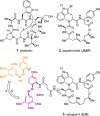Cryo-EM Resolves Molecular Recognition Of An Optojasp Photoswitch Bound To Actin Filaments In Both Switch States
- PMID: 33449370
- PMCID: PMC8048601
- DOI: 10.1002/anie.202013193
Cryo-EM Resolves Molecular Recognition Of An Optojasp Photoswitch Bound To Actin Filaments In Both Switch States
Abstract
Actin is essential for key processes in all eukaryotic cells. Cellpermeable optojasps provide spatiotemporal control of the actin cytoskeleton, confining toxicity and potentially rendering F-actin druggable by photopharmacology. Here, we report cryo electron microscopy (cryo-EM) structures of both isomeric states of one optojasp bound to actin filaments. The high-resolution structures reveal for the first time the pronounced effects of photoswitching a functionalized azobenzene. By characterizing the optojasp binding site and identifying conformational changes within F-actin that depend on the optojasp isomeric state, we refine determinants for the design of functional F-actin photoswitches.
Keywords: actin filaments; drug design; electron microscopy; photoswitch; protein structures.
© 2021 The Authors. Angewandte Chemie International Edition published by Wiley-VCH GmbH.
Conflict of interest statement
The authors declare no conflict of interest.
Figures



Similar articles
-
Optical Manipulation of F-Actin with Photoswitchable Small Molecules.J Am Chem Soc. 2020 May 20;142(20):9240-9249. doi: 10.1021/jacs.9b12898. Epub 2020 May 11. J Am Chem Soc. 2020. PMID: 32388980 Free PMC article.
-
Mechanism of actin polymerization revealed by cryo-EM structures of actin filaments with three different bound nucleotides.Proc Natl Acad Sci U S A. 2019 Mar 5;116(10):4265-4274. doi: 10.1073/pnas.1807028115. Epub 2019 Feb 13. Proc Natl Acad Sci U S A. 2019. PMID: 30760599 Free PMC article.
-
Near-atomic resolution for one state of F-actin.Structure. 2015 Jan 6;23(1):173-182. doi: 10.1016/j.str.2014.11.006. Epub 2014 Dec 18. Structure. 2015. PMID: 25533486 Free PMC article.
-
Cryo-EM structures of actin binding proteins as tool for drug discovery.Biochem Pharmacol. 2023 Aug;214:115680. doi: 10.1016/j.bcp.2023.115680. Epub 2023 Jul 1. Biochem Pharmacol. 2023. PMID: 37399949 Review.
-
Single particle cryo-EM-an optimal tool to study cytoskeletal proteins.Curr Opin Struct Biol. 2018 Oct;52:16-24. doi: 10.1016/j.sbi.2018.07.006. Epub 2018 Jul 26. Curr Opin Struct Biol. 2018. PMID: 30056307 Review.
Cited by
-
Next Generation Opto-Jasplakinolides Enable Local Remodeling of Actin Networks.Angew Chem Int Ed Engl. 2022 Nov 25;61(48):e202210220. doi: 10.1002/anie.202210220. Epub 2022 Oct 26. Angew Chem Int Ed Engl. 2022. PMID: 36048143 Free PMC article.
-
High-resolution structures of the actomyosin-V complex in three nucleotide states provide insights into the force generation mechanism.Elife. 2021 Nov 23;10:e73724. doi: 10.7554/eLife.73724. Elife. 2021. PMID: 34812732 Free PMC article.
-
Controlling the Covalent Reactivity of a Kinase Inhibitor with Light.Angew Chem Int Ed Engl. 2021 Sep 6;60(37):20178-20183. doi: 10.1002/anie.202103767. Epub 2021 Aug 11. Angew Chem Int Ed Engl. 2021. PMID: 34081840 Free PMC article.
-
Hypothesis-Driven, Structure-Based Design in Photopharmacology: The Case of eDHFR Inhibitors.J Med Chem. 2022 Mar 24;65(6):4798-4817. doi: 10.1021/acs.jmedchem.1c01962. Epub 2022 Mar 8. J Med Chem. 2022. PMID: 35258959 Free PMC article.
-
SiR-XActin: A fluorescent probe for imaging actin dynamics in live cells.bioRxiv [Preprint]. 2025 Feb 5:2025.02.04.636537. doi: 10.1101/2025.02.04.636537. bioRxiv. 2025. PMID: 39975322 Free PMC article. Preprint.
References
Publication types
MeSH terms
Substances
LinkOut - more resources
Full Text Sources
Other Literature Sources

